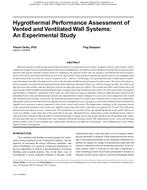Description
Based on analysis of the drying and wetting potentials of a particular local climate, designers choose wall systems with or without an air gap between a sheathing membrane and a cladding layer. In addition to the capillary break that the air gap provides, thereby reducing the moisture transfer from wet cladding to the interior of the wall, the airspace will add the thermal resistance of the wall system and reduce the heat flow across the wall system. These moisture and thermal performances are straightforward to understand if the air in the air cavity is assumed to be a “still air.” In this paper, an experimental study is undertaken to understand the impact of airflow through an air cavity on the moisture and thermal performance of wall systems.To achieve this objective three test panels are instrumented and monitored in the field-experimental setting: one with no air gap, another one with an air gap but restricted airflow, and the third one with an air gap and open for airflow. The second and third wall systems have the same air gap width but different top flashing designs creating vented and ventilated wall systems.For the wall systems’ orientation and boundary conditions considered in this study, the wall with no air gap accumulates relatively high moisture content on the sheathing board, stud, and bottom plate and also has high moisture content changes in a year cycle when compared to the vented and ventilated wall systems. In general, the hygrothermal performances of vented and ventilated wall systems are comparable. During the winter period when relatively high moisture accumulation occurs, the upper section of the ventilated wall system shows slightly lower moisture content compared to that of the vented wall system. The temperature readings of the sheathing boards in the vented and ventilated wall systems are slightly warmer than that of the wall with no air gap for 85.5% and 73% of the time (based on hourly data of a year), respectively. For the balance of a period of time, the sheathing boards in the walls with an air cavity are slightly cooler than that of the wall with an air gap. Although the low temperature on the sheathing board, which is caused by solar radiation-induced airflow, is beneficial during a cooling season, the air gap and the associated airflowmayreduce the heat gain that may be obtained from solar radiation during the heating season. The implications of air cavity and flashing design (airflow rate) on the heating and cooling load calculations of different orientations, wall configurations, and climate require further investigation.
Presented at Thermal Performance of Exterior Envelopes of Whole Buildings XII, December 2013
Citation: Thermal Performance of Exterior Envelopes of Whole Buildings XII
Product Details
- Published:
- 2013
- Number of Pages:
- 9
- File Size:
- 1 file , 4.6 MB
- Product Code(s):
- D-BldConf13-52




